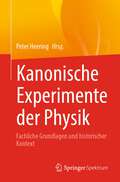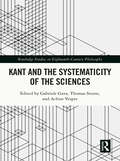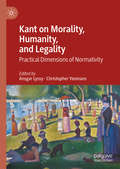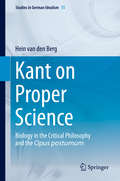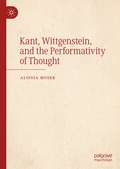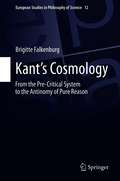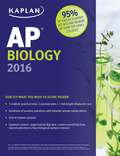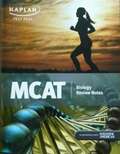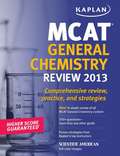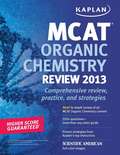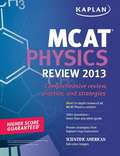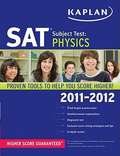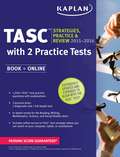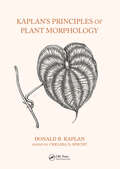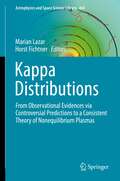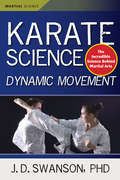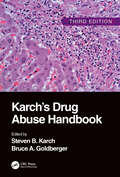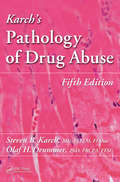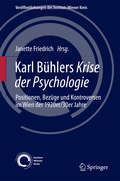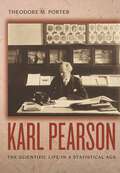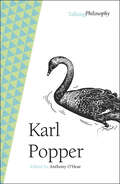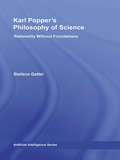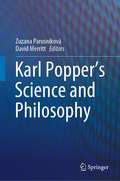- Table View
- List View
Kanonische Experimente der Physik: Fachliche Grundlagen und historischer Kontext
by Peter HeeringDieses Buch ermöglicht in 14 Fallstudien ein tieferes Verständnis von kanonischen Experimenten der Physik und bietet Hintergründe zu deren Aufbauten und Durchführung sowie dem jeweiligen historischen Kontext. Es diskutiert, wie genau diese Experimente ausgeführt wurden und welche physikalischen Gründe es für die Auswahl der verwendeten Instrumente gab. Ebenso wird dargestellt, warum die jeweiligen Forscher diese Experimente durchführten und wie diese Ergebnisse akzeptiert werden konnten.Während eine Reihe von diesen Experimenten und deren Methoden, wie das Geiger-Müller-Zählrohr oder das Youngsche Doppelspaltexperiment, Physiklehrkräften sowie (angehenden) Physikerinnen und Physikern zwar vom Funktionsprinzip her bekannt sind, liefert dieses Buch die Hintergründe um die Herausforderungen zu verstehen, die sich beim Experimentieren stellen und die auch den Reiz des experimentellen Arbeitens ausmachen können. Es verdeutlicht, warum Forschende forschen, worin die Motivation besteht und wie veränderlich naturwissenschaftliche Praktiken in der Zeit sind. Damit leisten die hier zusammengeführten Fallstudien einen Beitrag, Physik nicht als einen Wissenskanon, sondern als einen kulturell geprägten von Menschen getragenen Prozess zu verstehen. Das Buch eignet sich damit besonders für Studierende (sowohl fachwissenschaftlich als auch des Lehramts) sowie Lehrende an Universitäten und (Hoch-)Schulen.Der InhaltDas Hookesche Gesetz – Newtons prismatische Farbzerlegung – Das Coulombsche Gesetz – Youngs Doppelspaltexperiment – Das Ohmsche Gesetz – Die Messung der Lichtgeschwindigkeit durch Fizeau bzw. Foucault – Joules Bestimmung des mechanischen Wärmeäquivalents – Spektralanalyse nach Bunsen und Kirchhoff – Die Wilsonsche Nebelkammer – Das Franck-Hertz-Experiment – Millikans Bestimmung der Elementarladung – Das Geiger-Müller-Zählrohr – Kosmische Hintergrundstrahlung
Kant and the Laws of Nature
by Michela Massimi Angela BreitenbachLaws of nature play a central role in Kant's theoretical philosophy and are crucial to understanding his philosophy of science in particular. In this volume of new essays, the first systematic investigation of its kind, a distinguished team of scholars explores Kant's views on the laws of nature in the physical and life sciences. Their essays focus particularly on the laws of physics and biology, and consider topics including the separation in Kant's treatment of the physical and life sciences, the relation between universal and empirical laws of nature, and the role of reason and the understanding in imposing order and lawful unity upon nature. The volume will be of great interest to advanced students and scholars of Kant's philosophy of science, and to historians and philosophers of science more generally.
Kant and the Systematicity of the Sciences (Routledge Studies in Eighteenth-Century Philosophy)
by Thomas Sturm Gabriele Gava Achim VesperThis book provides the first comprehensive discussion regarding the role that Kant ascribes to systematicity in the sciences. It considers not only what Kant has to say on systematicity in general, but also how the systematicity requirement for science is specified in different fields of knowledge.The chapters are divided into three thematic sections. Part I is devoted to historical context. The chapters explore precursors of Kant’s account of the systematicity of the sciences. Part II addresses the application of systematicity to the special sciences – cosmology, physics, chemistry, logic, mathematics, the life sciences, and history. Finally, Part III explores the systematicity of philosophy.Kant and the Systematicity of the Sciences will be of interest to scholars and advanced students working on Kant and the history and philosophy of science.
Kant on Morality, Humanity, and Legality: Practical Dimensions of Normativity
by Ansgar Lyssy Christopher YeomansIt was not so long ago that the dominant picture of Kant’s practical philosophy was formalistic, focusing almost exclusively on his Groundwork of the Metaphysics of Morals and Critique of Practical Reason. However, the overall picture of Kant’s wide-ranging philosophy has since been broadened and deepened. We now have a much more complete understanding of the range of Kant’s practical interests and of his contributions to areas as diverse as anthropology, pedagogy, and legal theory. What remains somewhat obscure, however, is how these different contributions hang together in the way that Kant suggests that they must. This book explores these different conceptions of humanity, morality, and legality in Kant as main ‘manifestations’ or ‘dimensions’ of practical normativity. These interrelated terms play a crucial role in highlighting different rational obligations, their source(s), and their applicability in the face of changing circumstances.
Kant on Proper Science
by Hein van den BergThis book provides a novel treatment of Immanuel Kant's views on proper natural science and biology. The status of biology in Kant's system of science is often taken to be problematic. By analyzing Kant's philosophy of biology in relation to his conception of proper science, the present book determines Kant's views on the scientific status of biology. Combining a broad ideengeschichtlich approach with a detailed historical reconstruction of philosophical and scientific texts, the book establishes important interconnections between Kant's philosophy of science, his views on biology, and his reception of late 18th century biological theories. It discusses Kant's views on science and biology as articulated in his published writings and in the Opus postumum. The book shows that although biology is a non-mathematical science and the relation between biology and other natural sciences is not specified, Kant did allow for the possibility of providing scientific explanations in biology and assigned biology a specific domain of investigation.
Kant's Construction of Nature
by Michael FriedmanKant's Metaphysical Foundations of Natural Science is one of the most difficult but also most important of Kant's works. Published in 1786 between the first (1781) and second (1787) editions of the Critique of Pure Reason, the Metaphysical Foundations occupies a central place in the development of Kant's philosophy, but has so far attracted relatively little attention compared with other works of Kant's critical period. Michael Friedman's book develops a new and complete reading of this work and reconstructs Kant's main argument clearly and in great detail, explaining its relationship to both Newton's Principia and eighteenth-century scientific thinkers such as Euler and Lambert. By situating Kant's text relative to his pre-critical writings on metaphysics and natural philosophy and, in particular, to the changes Kant made in the second edition of the Critique, Friedman articulates a radically new perspective on the meaning and development of the critical philosophy as a whole.
Kant, Wittgenstein, and the Performativity of Thought
by Aloisia MoserThis book explores the idea that there is a certain performativity of thought connecting Kant’s Critique of Pure Reason and Wittgenstein’s Tractatus Logico-Philosophicus. On this view, we make judgments and use propositions because we presuppose that our thinking is about something, and that our propositions have sense. Kant’s requirement of an a priori connection between intuitions and concepts is akin to Wittgenstein’s idea of the general propositional form as sharing a form with the world. Aloisia Moser argues that Kant speaks about acts of the mind, not about static categories. Furthermore, she elucidates the Tractatus’ logical form as a projection method that turns into a so-called ‘zero method’, whereby propositions are merely the scaffolding of the world. In so doing, Moser connects Kantian reflective judgment to Wittgensteinian rule-following. She thereby presents an account of performativity centering neither on theories nor methods, but on the application enacting them in the first place.
Kant’s Cosmology: From the Pre-Critical System to the Antinomy of Pure Reason (European Studies in Philosophy of Science #12)
by Brigitte FalkenburgThis book provides a comprehensive account of Kant’s development from the 1755/56 metaphysics to the cosmological antinomy of 1781. With the Theory of the Heavens (1755) and the Physical Monadology (1756), the young Kant had presented an ambitious approach to physical cosmology based on an atomistic theory of matter, which contributed to the foundations of an all-encompassing system of metaphysics. Why did he abandon this system in favor of his critical view that cosmology runs into an antinomy, according to the Critique of Pure Reason (CPR)? This book answers this question by focusing on Kant’s methodology and the internal problems of his 1755/56 theory of nature. A decisive role for Kant’s critical turn plays the argument from incongruent counterparts (1768), which drew much attention among philosophers of science, though not sufficiently in Kant research. Furthermore, the book analyses the genesis of the cosmological antinomy in the 1770s, the logical structure of the antinomy in the CPR, its relation to transcendental idealism, as explained in the “experiment of pure reason” (1787), and its role for the teleology of human reason. The book is addressed to Kant scholars, philosophers of science, and students of Kant’s philosophy.
Kaplan AP Biology 2016
by Linda Brooke Stabler Mark Metz Allison WilkesThe Advanced Placement exam preparation guide that delivers 75 years of proven Kaplan experience and features exclusive strategies, practice, and review to help students ace the NEW AP Biology exam!Students spend the school year preparing for the AP Biology exam. Now it's time to reap the rewards: money-saving college credit, advanced placement, or an admissions edge. However, achieving a top score on the AP Biology exam requires more than knowing the material--students need to get comfortable with the test format itself, prepare for pitfalls, and arm themselves with foolproof strategies. That's where the Kaplan plan has the clear advantage.Kaplan's AP Biology 2016 has been updated for the NEW exam and contains many essential and unique features to improve test scores, including:2 full-length practice tests and a full-length diagnostic test to identify target areas for score improvementDetailed answer explanationsTips and strategies for scoring higher from expert AP teachers and students who scored a perfect 5 on the examEnd-of-chapter quizzesTargeted review of the most up-to-date content and key information organized by Big Idea that is specific to the revised AP Biology exam Kaplan's AP Biology 2016 provides students with everything they need to improve their scores--guaranteed. Kaplan's Higher Score guarantee provides security that no other test preparation guide on the market can match. Kaplan has helped more than three million students to prepare for standardized tests. We invest more than $4.5 million annually in research and support for our products. We know that our test-taking techniques and strategies work and our materials are completely up-to-date for the NEW AP Biology exam. Kaplan's AP Biology 2016 is the must-have preparation tool for every student looking to do better on the NEW AP Biology test!
Kaplan MCAT Biology Review Notes
by The Staff of KaplanKaplan's successful classroom MCAT test prep experience is now replicated in this new five-book set. Each book contains commentary and advice from top Kaplan instructors and provides students with tips, strategies, and test-taking practice, as well as hundreds of practice questions, access to 3 online MCAT exams, 15 Fast Fact videos with expert advice from a top-ranked MCAT teacher, and full-color illustrations. A full-color guide featuring all-new, complete test targeted biology review for the MCAT, Kaplan MCAT Biology includes over 500 practice questions (hundreds more than the competition) and three full-length biology practice sections. Expert commentary and instruction from a top Kaplan teacher includes tips, tricks, and test expertise. Vibrant illustrations, charts, and graphs from the pages of Scientific American, make this guide a compelling source of MCAT prep.
Kaplan MCAT General Chemistry Review Notes
by KaplanKaplan's successful classroom MCAT test prep experience is now replicated in this new five-book set. Each book contains commentary and advice from top Kaplan instructors and provides students with tips, strategies, and test-taking practice, as well as hundreds of practice questions, an online MCAT, and full-color illustrations. This full-color guide features all-new, complete test-targeted general chemistry review for the MCAT, as well as expert commentary and instruction from a top Kaplan teacher. Kaplan MCAT General Chemistry provides more practice questions than any other guide (over 400 questions) along with three full-length chemistry practice sections. Also included are vibrant illustrations, charts, graphs, and diagrams from the pages of Scientific American.
Kaplan MCAT Organic Chemistry Review
by KaplanKaplan's successful classroom MCAT test prep experience is now replicated in this new five-book set. Each book contains commentary and advice from top Kaplan instructors and provides students with tips, strategies, and test-taking practice, as well as hundreds of practice questions, an online MCAT, and full-color illustrations. Kaplan MCAT Organic Chemistry features all-new, complete test-targeted organic chemistry review for the MCAT exam, along with expert commentary and instruction from a top Kaplan teacher. It features dozens more practice questions than the competition (over 300 in all) along with three full-length organic chemistry practice sections, and vibrant illustrations and art straight from the pages of Scientific American.
Kaplan MCAT Physics Review Notes
by KaplanKaplan's successful classroom MCAT test prep experience is now replicated in this new five-book set. Each book contains commentary and advice from top Kaplan instructors and provides students with tips, strategies, and test-taking practice, as well as hundreds of practice questions, access to 3 online MCAT exams, 15 Fast Fact videos with expert advice from a top-ranked MCAT teacher, and full-color illustrations. A full-color guide featuring all-new, complete test targeted physics review for the MCAT, "Kaplan MCAT Physics "includes over 500 practice questions (hundreds more than the competition) and three full-length practice sections. Expert commentary and instruction from a top Kaplan teacher includes tips, tricks, and test expertise. Vibrant illustrations, charts, and graphs from the pages of "Scientific American," make this guide a compelling source of MCAT prep.
Kaplan SAT Subject Test: Physics 2011-2012
by Hugh HendersonKaplan SAT Subject Test: Physics features: A full-length diagnostic test and practice tests, Focused chapter summaries, highlights, and quizzes, Detailed answer explanations, Proven score-raising strategies and End-of-chapter quizzes. The book is the most up-to-date guide with complete coverage of both the content review and strategies students need for success on test day.
Kaplan TASC Strategies, Practice, and Review 2015-2016
by KaplanComprehensive content review, strategies, and practice for all sections of the TASC (Test Assessing Secondary Completion) from top test experts.
Kaplan's Principles of Plant Morphology
by Donald Kaplan Chelsea D. SpechtKaplan's Principles of Plant Morphology defines the field of plant morphology, providing resources, examples, and theoretical constructs that illuminate the foundations of plant morphology and clearly outline the importance of integrating a fundamental understanding of plant morphology into modern research in plant genetics, development, and physiology. As research on developmental genetics and plant evolution emerges, an understanding of plant morphology is essential to interpret developmental and morphological data. The principles of plant morphology are being brought into studies of crop development, biodiversity, and evolution during climate change, and increasingly such researchers are turning to old texts to uncover information about historic research on plant morphology. Hence, there is great need for a modern reference and textbook that highlights past studies and provides the synthesis of data necessary to drive our future research in plant morphological and developmental evolution. Key Features Numerous illustrations demonstrating the principles of plant morphology Historical context for interpretations of more recent genetic data Firmly rooted in the principles of studying plant form and function Provides evolutionary framework without relying on evolutionary interpretations for plant form Only synthetic treatment of plant morphology on the market Related Titles Les, D. H. Aquatic Dicotyledons of North America: Ecology, Life History, and Systematics (ISBN 978-1-4822-2502-0) Les, D. H. Aquatic Monotyledons of North America: Ecology, Life History, and Systematics (ISBN 978-1-1380-5493-6) Bowes, B. G. Colour Atlas of Woody Plants and Trees (ISBN 978-0-3674-7398-3) Bahadur, B. et al., eds. Asymmetry in Plants: Biology of Handedness (ISBN 978-1-1385-8794-6)
Kappa Distributions: From Observational Evidences via Controversial Predictions to a Consistent Theory of Nonequilibrium Plasmas (Astrophysics and Space Science Library #464)
by Marian Lazar Horst FichtnerThis book presents recent results on the modelling of space plasmas with Kappa distributions and their interpretation. Hot and dilute space plasmas most often do not reach thermal equilibrium, their dynamics being essentially conditioned by the kinetic effects of plasma particles, i.e., electrons, protons, and heavier ions. Deviations from thermal equilibrium shown by these plasma particles are often described by Kappa distributions. Although well-known, these distributions are still controversial in achieving a statistical characterization and a physical interpretation of non-equilibrium plasmas.The results of the Kappa modelling presented here mark a significant progress with respect to all these aspects and open perspectives to understanding the high-resolution data collected by the new generation of telescopes and spacecraft missions.The book is directed to the large community of plasma astrophysics, including graduate students and specialists from associated disciplines, given the palette of the proposed topics reaching from applications to the solar atmosphere and the solar wind, via linear and quasilinear modelling of multi-species plasmas and waves within, to the fundamental physics of nonequilibrium plasmas.
Karate Science: Dynamic Movement (Martial Science)
by J. D. SwansonDynamics, motion, and sensation are karate’s connective tissue—and they are the heart of this book. As a lifelong student of martial arts, J. D. Swanson, PhD, had searched through piles of books on form and function. Stand here, they said. Step there. But where movement was concerned, not one of them went deep enough. No one discussed dynamics—the actual feeling of the moves. Martial instruction, both in print and in person, tends to focus on stances and finishing positions. But dynamics, motion, sensation . . . they are karate’s connective tissue—and they are the heart of this book. Karate Science: Dynamic Movement will help you understand the mechanics of the human body. Swanson describes these principles in incredible detail, drawing on examples from several styles of karate, as well as aikido, taekwondo, and judo. Whatever your martial background, applying this knowledge will make your techniques better, stronger, and faster. • Understand the major types of techniques, including their outward appearances and internal feelings. • Master the core principles behind these feelings. • Learn the biomechanics and dynamics of core movement. Karate Science: Dynamic Movement is filled with examples, anecdotes, and beautiful illustrations. Although Shotokan karate is the author’s frame of reference, the principles of human mechanics translate to all martial styles. This book features • Clear and insightful explanations of dynamic movement. • Over 100 illustrations. • Profound but accessible analysis of the kihon, or fundamentals of Shotokan karate. “Karate Science: Dynamic Movement is rooted in the teachings of the masters,” Swanson says. “This book nucleates that knowledge, clarifying and distilling the key principles behind movement dynamics. This is the next evolution of karate books.”
Karch's Drug Abuse Handbook
by Steven B. Karch and Bruce A. GoldbergerKarch’s Drug Abuse Handbook, Third Edition remains the quintessential compendium addressing the pharmacological, medical, and legal aspects of drugs and informing the forensic community of the latest scientific advances and emergent practices. For this edition, Dr. Karch has brought on clinical and forensic toxicology expert Dr. Bruce Goldberger, editor-in-chief of the Journal of Analytical Toxicology and president of the American Board of Forensic Toxicology, to serve as co-editor. In addition, world-renowned scientists and medical professionals have contributed their work and expertise in tackling the latest developments in drug testing, drug-related medical emergencies, and the drug toxicology. Topics addressed include genetic testing in drug death investigation, pathology, toxicogenetics, alcohol, post-mortem toxicology, new psychoactive substances, the latest legal issues and challenges as well as drugs and drug testing in sports, and the ethical, legal, and practical issues involved. Vivid pictures and diagrams throughout illustrate the pathological effects of drugs and the chemical make-up and breakdown of abused drugs. With unparalleled detail, the latest research and the highest level of authoritative medical scientific information, The Drug Abuse Handbook, Third Edition remains the definitive resource for drug related issues.
Karch's Pathology of Drug Abuse
by Steven B. Karch MD Olaf DrummerWritten in the same accessible manner as previous editions, the fifth edition of Karch‘s Pathology of Drug Abuse is an essential guide to the pathology, toxicology, and pharmacology of commonly abused drugs. The book focuses on the investigation of drug-related deaths, practical approaches to the detection of drug abuse, and discussions of medical
Karl Bühlers Krise der Psychologie
by Janette FriedrichIm Mittelpunkt des Bandes steht Karl Bühlers 1927 veröffentlichte Schrift zur „Krise der Psychologie“. Bühler setzt sich darin mit den verschiedenen Ansätzen zur Erforschung psychologischer Phänomene auseinander. Seine Analyse der sich seit Ende des 19. Jahrhunderts als eigenständige Disziplin konstituierenden Psychologie nehmen die Autoren zum Ausgangspunkt, um die „Positionen, Bezüge und Kontroversen im Wien der 1920er/30er Jahre“ zu beleuchten. Dabei stellen sie bisher wenig beachtete theoretische Positionen Karl Bühlers vor und präsentieren neue historische Fakten zu seiner Schaffenszeit an der Wiener Universität.Die Themen der Beiträge reichen vom Neubeginn der Wiener Philosophie mit der Besetzung der drei Lehrstühle im Jahre 1922 über die Forschungen zum Film unter Leitung von Karl Bühler in den 1930er Jahren bis hin zu neuen Erkenntnissen der NS-Provenienzforschung zur Bibliothek von Karl und Charlotte Bühler. Die Verbindungen zwischen Bühlers Krisenanalyse und dem Forschungsprogramm der Brentanoschule werden aufgezeigt, sein Interesse am Medienbegriff des Psychologen Fritz Heider ebenso detailreich diskutiert wie Bühlers in den 1930er Jahren begonnenes Projekt einer Lebenspsychologie und einer Sematologie als allgemeine Zeichentheorie. Dabei beantworten die Autoren die Frage nach der Aktualität seines Denkens ganz unterschiedlich.Mit der Erschließung neuer Quellen und der Rekonstruktion historischer Kontexte sowie durch komparative Textstudien leisten die Autoren einen originellen Beitrag zur Wissenschaftsgeschichte, insbesondere zur Geschichte der Psychologie und der Philosophie wie auch zur Institutionsgeschichte der Wiener Universität am Anfang des 20. Jahrhunderts. Der Band richtet sich an Spezialisten auf diesen Gebieten, aber auch an Psychologen, Sprachwissenschaftler, Erziehungswissenschaftler und Philosophen.
Karl Pearson: The Scientific Life in a Statistical Age
by Theodore M. PorterKarl Pearson, founder of modern statistics, came to this field by way of passionate early studies of philosophy and cultural history as well as ether physics and graphical geometry. His faith in science grew out of a deeply moral quest, reflected also in his socialism and his efforts to find a new basis for relations between men and women. This biography recounts Pearson's extraordinary intellectual adventure and sheds new light on the inner life of science. Theodore Porter's intensely personal portrait of Pearson extends from religious crisis and sexual tensions to metaphysical and even mathematical anxieties. Pearson sought to reconcile reason with enthusiasm and to achieve the impersonal perspective of science without sacrificing complex individuality. Even as he longed to experience nature directly and intimately, he identified science with renunciation and positivistic detachment. Porter finds a turning point in Pearson's career, where his humanistic interests gave way to statistical ones, in his Grammar of Science (1892), in which he attempted to establish scientific method as the moral educational basis for a refashioned culture. In this original and engaging book, a leading historian of modern science investigates the interior experience of one man's scientific life while placing it in a rich tapestry of social, political, and intellectual movements.
Karl Popper (Talking Philosophy)
by Anthony O’HearSir Karl Popper was a major thinker of the twentieth century, one who – as Anthony O'Hear writes in his new Foreword – 'has had a beneficent influence on those who have come under the spell of his thought and of the inimitable prose in which he articulates it'. It is now twenty-five years since Popper died, and thus seems – after a quarter of a century – an apposite moment to revaluate his impact, significance, and influence. The several chapters in this classic volume focus on many key elements of Popper's thought and philosophy. They are by no means uncritical, but afford Popper the respect due to a philosopher who wrote always with a degree of clarity, precision, and directness rare in the academic world of his time, and – as O'Hear puts it – 'even rarer subsequently'. This important book constitutes an essential introduction to some of the most esteemed philosophical writing of our times.
Karl Popper's Philosophy of Science: Rationality without Foundations (Routledge Studies in the Philosophy of Science)
by Stefano GatteiThis book seeks to rectify misrepresentations of Popperian thought with a historical approach to Popper’s philosophy, an approach which applies his own mature view, that we gain knowledge through conjectures and refutations, to his own development, by portraying him in his intellectual growth as just such a series. Gattei seeks to reconstruct the logic of Popper’s development, in order to show how one problem and its tentative solution led to a new problem.
Karl Popper's Science and Philosophy
by Zuzana Parusniková David MerrittOf all philosophers of the 20th century, few built more bridges between academic disciplines than Karl Popper. He contributed to a wide variety of fields in addition to the epistemology and the theory of scientific method for which he is best known. This book illustrates and evaluates the impact, both substantive and methodological, that Popper has had in the natural and mathematical sciences. The topics selected include quantum mechanics, evolutionary biology, cosmology, mathematical logic, statistics, and cognitive science. The approach is multidisciplinary, opening a dialogue across scientific disciplines and between scientists and philosophers.
